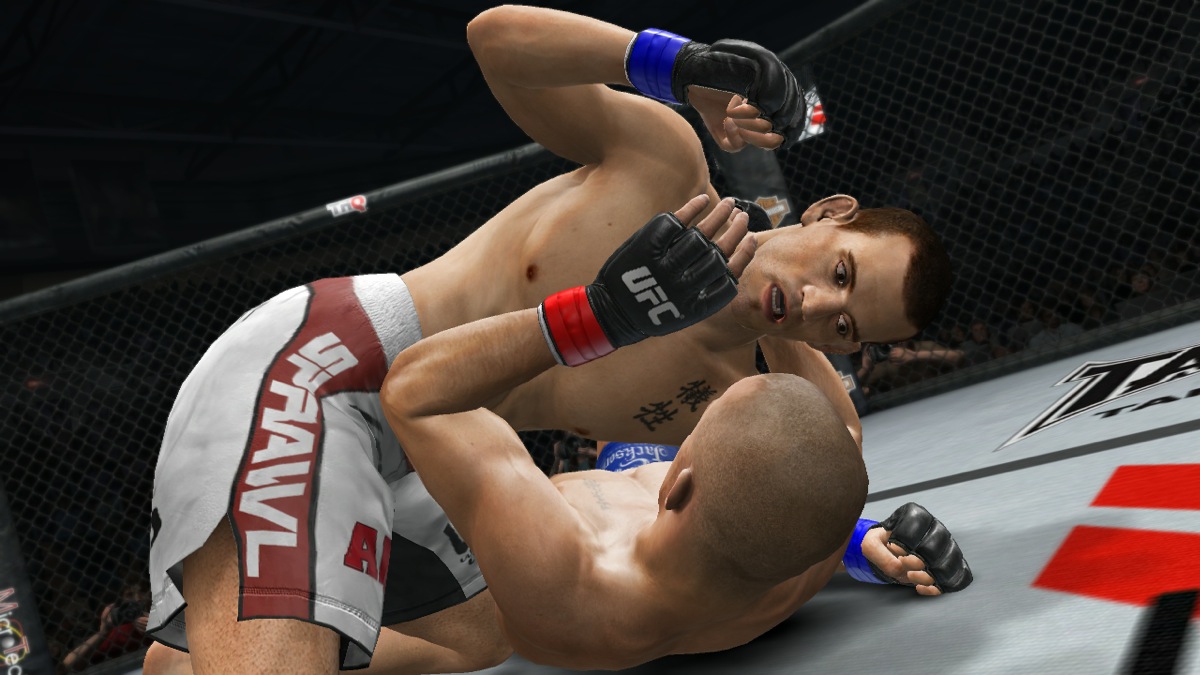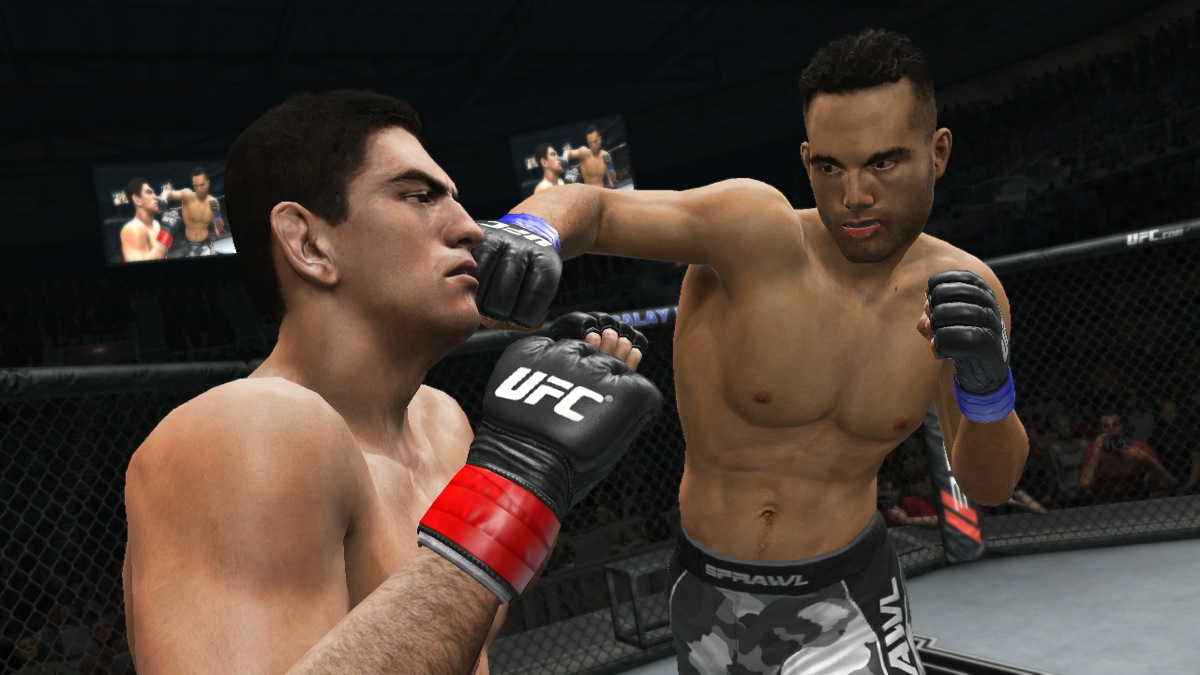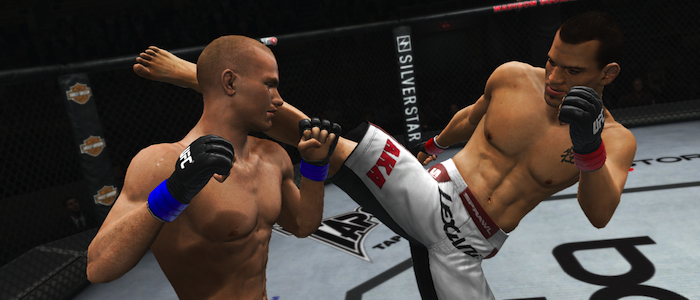[tab:Review]
Its always intimidating learning about an unfamiliar, but wildly popular topic. Watching your first football game without knowing what a first down is, learning a foreign language or picking up a gamepad for the first time can all be imposing experiences. That’s how I felt before going to the preview event for UFC Undisputed 3 last month. When I walked away, two things had changed. First, I learned what the term “ground game” means. Second, I was a fan of both the sport of mixed martial arts and the work that THQ has done on behalf of it.
UFC Undisputed 3 is clearly a labor of love. The development team at Yukes spent countless hours listening to fans, addressing concerns and conducting research that resulted in this game bringing in concepts and philosophies that broaden it beyond the average sports simulation. At its heart, UFC 3 is a carefully modeled, detail-obsessed and thrilling digitization of the Octagon experience. This time out, THQ has freed the game from its shackles of being too rooted in reality, giving players more ways to customize the experience and build their own UFC legacy.
After wisely breaking from the annual sports release cycle, the team consulted with fighters, trainers and, interestingly, competitive fighting game players. The result is combat that exists in the delicate space between boringly realistic and fantastically absurd. In addition to a rich tutorial and training system, which I advise every player to spend time with, the game features a slate of standard modes including exhibition and career. Quick fights can be set to use the fighters’ full statistics, balance to focus more on choice according to style and an option to streamline things for tournament play by taking out stoppages to check cuts and other things that can end a fight prematurely.
This time out, career mode has seen a huge overhaul. The goal behind the renovation is to get gamers out of the menus, off the spreadsheet and into a fight as quickly as possible. When you start your career, you can choose to create a fighter with the fluid and fast toolset (that should absolutely be included in the next iteration of WWE) or rewrite history using a real fighter. From there, you’ll begin in the WFA, fighting your way up to the championship bout. Win and you’ll get an invite from the UFC. One thing you should be careful of is taking that invitation too soon. You’ll likely be overmatched unless you spend some time defending your title and engaging in training drills to raise your stats.
The road to your first championship fight serves as a well-paced tutorial. Between each fight, you’ll be allocated a small number of activities. Mike Goldberg leads you through the different types including sparring and training drills, the new game plan feature and time spent learning and improving moves at one of 6 camps, including Greg Jackson’s Gym and Wolfslair. Choosing a game plan, focuses your goals in the match. Succeed in the planning phase against a sparring partner and you can receive the max benefit, but you still need to execute in the real match to lock in those increases.
Camps play a big part, and the gyms are modeled after the real-life counterparts. There, you can learn new moves based on what the gym is known for and improve the ones you’ve already acquired. You can visit all of the different facilities at the start of your career, but you will eventually need to choose one. You’ll earn the gym trainer in your corner during fights and access to more powerful skills once you increase your camp loyalty.

Managing your actions is a big part of getting ready for a fight and your long-term growth as a fighter. Once in the Octagon, though, it’s a matter of playing to your strengths, negating an opponent’s weaknesses and doing unto him before he can do unto your face. In order to pick that strategy, though, you’ll need to have an understanding of the different rating categories. Are you a stand-up striker? Do you like to take things to the ground and pound it out? Maybe you just want to twist your foe’s body into the most uncomfortable position imaginable for a tapout. It’s up to you.
Combat is more fluid than in years past, making better use of both the amateur and pro controls for changing position in the clinch or on the ground. I recommend that new players start with the amateur controls and, after becoming comfortable with everything else in the fight, bump it up to pro. The advanced scheme gives you a level of control that is necessary for the higher difficulties and real opponents both online and off. The new submission system, reflects the intellectual nature of the fight, creating a cat-and-mouse effect with the minigame. The aggressor chases the perfect position while the defender is working hard to squirm out and keep the fight going.
Once you are satisfied with your skills against the AI, it’s time to take your game online. There you can play friendly matches, compete in ranked fights and form your own online Camps, which serve as the UFC equivalent of clans. When part of a camp, all of your ranked matches contribute to the overall record, reaching milestones you can show them on your customizable banner. You can also spar with friends using the Camp gym menu. It’s a great way to stay connected and make the most of the fluid online play. In my time with the game, I experienced no lag, only regular beat downs due to my weak skills.
Another major new addition this year is Pride. Founded in Japan, these fights take place in a ring that is smaller than the Octagon. The battles are brutal, with kicks the heads of your downed opponent falling in the realm of legality. Pride fights can be taken on by any UFC fighter and vice versa. Fighters that have a history in both arenas have two different incarnations with different stats, reflecting different periods in their careers. Pride offers fantastic new variety, with the opportunity for fantasy matches in addition to another new inclusion, mirror matches.

When you are ready to take a break from pounding on an opponent, you can sit back and take a look at your past successes. If you’ve got the space on the hard drive, you can have the game save your last 50 rounds. UFC Undisputed 3 comes with a highlight reel editor that allows you to add effects and filters. After you’ve crafted the perfect brag video, upload it and share with your friends. Don’t want to take the time? After each fight, the game gives you the option to automatically render a highlight reel from the fight. Be warned, this will take a chunk of time.
As much as I love being able to pick up and fight quickly, UFC Undisputed 3 isn’t perfect. My two main gripes with the game detract from the otherwise stellar career mode. First, you cannot change the difficulty in career mode once you start with a fighter. This means that as you improve, you might be in a position where retirement is the better option than fighting and winning every battle without challenge. Second, some of the training drills are confusing, with movement controls that aren’t well explained. This would be mitigated by an opportunity to practice them independently, but it isn’t there. This feel like relatively minor complaints, but given that you are encouraged not to do the same drill over and over, there really is no way to address it or improve without lots of failure.
UFC Undisputed 3 is an example of what every sports simulation game should be. By choosing not to be bound by how people think of the sport, Yukes managed to deliver a product that is both more realistic and enjoyable than both of the previous UFC titles. Any game that can make me a fan of its subject matter overnight is a winner in my book.
Review copy of the game provided by publisher. Primary play on Xbox 360.
[tab:Screenshots]
[tab:END]
